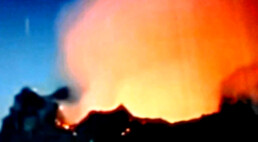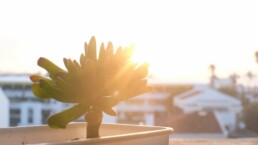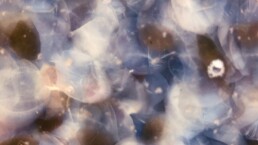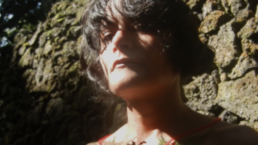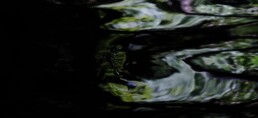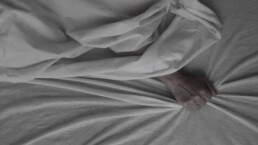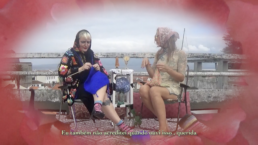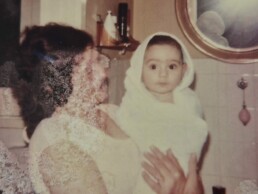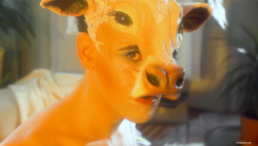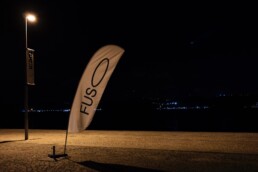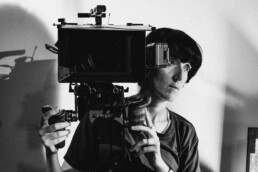FUSO INSULAR 2025 – 23 a 26 de Outubro
26 Outubro, 18h
Arquipélago – Centro de Artes Contemporâneas, Ribeira Grande
LABORATÓRIO IMAGEM EM MOVIMENTO
Curadoria: André Laranjinha e Rachel Korman
O Laboratório Imagem em Movimento é um espaço/tempo dedicado à criação de obras em vídeo. O propósito do programa de residência é dar oportunidade às pessoas que vivem nos Açores – sejam ou não artistas – com interesse nas artes cinematográficas, de realizarem os seus projetos em vídeo, munindo-as de conteúdos e referências e apoiando-as no desenvolvimento e concretização dos seus trabalhos. Entre encontros teóricos e práticos, estimula-se a reflexão sobre a imagem em movimento como expressão artística transversal a todas as práticas, cruzando linguagens do cinema experimental, das artes visuais, da performance, da fotografia, da literatura e dos meios digitais.
A 6ª edição do Laboratório Imagem em Movimento contou com a realizadora Cláudia Varejão na orientação teórica e o artista André Laranjinha no acompanhamento prático. Durante o verão açoriano, em encontros semanais e num processo colaborativo entre as participantes, Dryelle Andrade, Kateryna Kondratieva, Luisa Borges, Margarida Benevides, Maria Jorge Martins, Melrose, Rafaella Antunes e Rita Bolieiro propuseram ideias, criaram guiões, captaram imagens e sons e aventuraram-se por programas de edição, para contarem as suas histórias.
A ilha e a natureza que nela habita atravessam quase todas as obras. Estão no filme da Maria Jorge Martins, uma reflexão para além da matéria criada por uma erupção; surgem como lugar de culto na visão de Rita Bolieiro; revelam-se nos pequenos gestos do cotidiano no vídeo de Raffaela Antunes; ou ainda nas plantas ‘invasoras’, metáfora com que Kateryna Kondratieva dá voz às mulheres ucranianas refugiadas da guerra em São Miguel. Dryelle Andrade tece uma ode ao tempo, fazendo do envelhecimento e da ancestralidade gestos de resistência, enquanto Margarida Benevides busca, através dele, criar a imagem da mãe que não conheceu. Já Luísa Borges expõe o desconforto emocional aprisionado na mente de uma pessoa, que Melrose liberta numa obra ficcional sobre a história de uma vampira coquette e uma bruxa misteriosa. Autobiográficas ou ficcionais, todas estas obras encontram no território açoriano o seu denominador comum.
Os vídeos são apresentados na presença de seus criadores, na Black Box do Arquipélago – Centro de Artes Contemporâneas, espaço e equipa fundamentais para a realização do programa de residências do FUSO INSULAR. Também a Biblioteca Pública e Arquivo Regional de Ponta Delgada, com a dedicação da sua equipa, foi decisiva para a concretização do Laboratório Imagem em Movimento, acolhendo os encontros semanais das participantes ao longo dos meses de residência.
Em seis edições do Laboratório Imagem em Movimento já foram criados 45 filmes, constituindo uma importante representação da videoarte na Região Autónoma dos Açores.
A ILHA E… – Maria Jorge Martins
A ilha nasceu como todas as ilhas, de uma erupção. Uma erupção de ideias, de conceitos e como todas as ilhas, apresentou-se diante de mim como uma realidade dual e confusa. Ao nascer, abriu caminho a reflexões profundas e investigações constantes.
AINDA (NÃO) EM CASA – Kateryna Kondratieva
O filme é um mosaico que combina as vozes das mulheres ucranianas que abandonaram as suas casas por causa da guerra com as imagens de plantas introduzidas dos Açores que criam raízes no novo solo. Através de componentes documentais e metafóricos, explora a experiência de perda e ganho, emigração e adaptação.Que oportunidades se abrem diante delas e quais escolhem consciente ou inconscientemente: algumas são casuais – aparecem e desaparecem; outras – naturalizadas – encontram o seu lugar e coexistem harmoniosamente com o meio envolvente; e invasoras, alterando a paisagem envolvente.
ARA – Rita Bolieiro
Nesta ilha onde pedras são profetas e altares, a natureza e os seus vestígios são divinos. O culto faz-se através de gestos e oferendas: tudo o que da ilha vem, a ela volta.
Fragmentos do que não se escapa – Dryelle Andrade
Entre flores, paredes e silêncios, este é um ensaio sobre o tempo. Cada fragmento abre uma brecha na linearidade, onde o envelhecimento deixa de ser apenas o destino final e passa a ser gesto de resistência e memória inscrita contra toda ordem que busca apagá-lo.
Natureza In(Visível) – Rafaella Antunes
Sobre o que a natureza distribui em formas fugazes. A presente obra surge através do questionamento, como viver neste mundo? Na tentativa de conceber a força da existência que permeia intrinsecamente a Natureza In(Visível) do cotidiano. — A Natureza é como a teia da aranha, que tanto revela como vela a aranha. Se a Natureza é Ilusão ou Revelação isso não depende de si mas sim do ser que a contempla. (ROHDEN, 1978, p. 71.)
quarto minguante – Luisa Borges
A ruminação mental de uma mulher que se isola no seu quarto e procura o conforto num espaço que se torna cada vez mais exíguo.
quem é que ela pensa que é? – Melrose
Em pequenos ambientes, de qualquer intriga nasce uma lenda…
JOSEFINA e PILLAR são duas amigas da terrinha que comentam diariamente o seu habitat natural. Baseiam a sua amizade na confiança que constroem a criticar os outros. Narram a história de AGATHA, uma vampira coquette, e a sua amizade com DARIA, uma bruxa misteriosa.
Zoraida – Margarida Benevides
Esta é uma viagem poética através do tempo, onde não existem memórias. Existem apenas fragmentos capturados em fotografias desvanecidas, histórias contadas por aqueles que a amaram e alguma imaginação.Tudo serve de arrimo para criar uma imagem da mãe. As ondas do mar, os sussurros do vento, os desenhos nas nuvens ou o sabor dos figos. Porque o seu lugar não é no passado, mas sim no presente de cada um dos seus dias.
FUSO INSULAR 2025 – October 23rd to 26th
October 26th, 6pm
Arquipélago – Centro de Artes Contemporâneas, Ribeira Grande
MOVING IMAGE LABORTORY
Curators: André Laranjinha and Rachel Korman
The Moving Image Laboratory is a space/time dedicated to the creation of video works. The purpose of the residency program is to provide opportunities for people living in the Azores—whether they are artists or not —who have an interest in the cinematic arts, to realize their video projects by equipping them with content and references, and supporting them in the development and realization of their work. The reflection on the moving image is stimulated through theoretical and practical meetings, which establish the moving image as an artistic expression that bridges all practices, blending languages from experimental cinema, visual arts, performance, photography, literature, and digital media.
In this edition of the Moving Image Laboratory, director Cláudia Varejão was responsible for the theoretical component, while artist André Laranjinha provided technical support. During the Azorean summer, in weekly gatherings and through a collaborative process among the participants, Dryelle Andrade, Kateryna Kondratieva, Luisa Borges, Margarida Benevides, Maria Jorge Martins, Melrose, Rafaella Antunes and Rita Bolieiro proposed ideas, created scripts, captured images and sounds, and ventured into editing programs, each telling their own story.
The island, and the nature that inhabits it, permeate almost every work. They appear in Maria Jorge Martins’s film, a reflection that reaches beyond the matter born of an eruption; emerge as a place of worship in the vision of Rita Bolieiro; reveal themselves in the small gestures of everyday life in Raffaela Antunes’s video; or in the ‘invasive’ plants, a metaphor through which Kateryna Kondratieva gives voice to Ukrainian women refugees of war living in São Miguel. Dryelle Andrade weaves an ode to time, turning aging and ancestry into gestures of resistance, while Margarida Benevides seeks, through it, to create the image of the mother she never knew. Luísa Borges, in turn, exposes the emotional unrest imprisoned in the mind, which Melrose releases in a fictional work about the story of a coquettish vampire and a mysterious witch. Autobiographical or fictional, all these works find in the Azorean territory their common ground.
The videos are presented in the presence of their creators at the Black Box of Arquipélago – Centro de Artes Contemporâneas, a space and a team that have been fundamental to the realization of the FUSO INSULAR residency program. The Public Library and Regional Archive of Ponta Delgada, through the dedication of its team, was also decisive in the implementation of the Moving Image Laboratory, hosting the participants’ weekly gatherings throughout the months of residency.
Over six editions of the Moving Image Laboratory, 45 films have been created, constituting an important representation of video art in the Autonomous Region of the Azores.
the Island and… – Maria Jorge Martins
The island was born like all islands, from an eruption. An eruption of ideas, of concepts, and like all islands, it presented itself to me as a dual and confusing reality. At its birth, it opened the way to deep reflections and constant investigations.
(Not) at home yet – Kateryna Kondratieva
The film is a mosaic that combines the voices of Ukrainian women who left their homes because of the war with images of plants brought to the Azores that took roots in the new soil. Through both documentary and metaphorical elements, it explores the experience of loss and gain, emigration and adaptation.What opportunities are ofered to them, and which of those they choose consciously or unconsciously: some are casual — appearing and disappearing; others, naturalized — finding their place and coexisting harmoniously with the surrounding environment; and the invasive, altering the surrounding landscape.
ARA – Rita Bolieiro
On this island, where stones are both prophets and altars, nature and its traces are divine. Worship is carried out through gestures and offerings: everything that comes from the island returns to it.
Fragments of the Inescapable – Dryelle Andrade
Amid flowers, walls, and silences, this is an essay on time. Each fragment opens a breach in linearity, where aging ceases to be merely the final destination and becomes instead an act of resistance and a memory inscribed against every order that seeks to erase it.
In(Visible) Nature – Rafaella Antunes
In(Visible) Nature Is about what nature can review in its different forms. This work results from the questioning: how to live in this world? In the attempt to conceive the force of existence that intrinsically permeates the In(Visible) Nature of everyday life. — Nature is like the spider’s web, which both reveals and conceals the spider. Whether Nature is Illusion or Revelation does not depend on itself, but on the being who contemplates it. (ROHDEN, 1978, p. 71.)
waning phase of the mood – Luisa Borges
A woman’s musings as she isolates herself in her room, seeking comfort in a space that becomes increasingly confined.
Who Does She Think She Is? – Melrose
In small communities, any intrigue can give rise to a legend…JOSEFINA and PILLAR are two local friends who spend their days commenting about their hamlet. Their friendship rests on the trust they build by criticizing others. They narrate the story of AGATHA, a coquettish vampire, and her friendship with DARIA, a mysterious witch.
Zoraida – Margarida Benevides
This is a poetic journey through time, where no memories exist. There are only fragments captured in faded photographs, stories told by those who loved her, and a touch of imagination.Everything becomes a support for creating the image of the mother: the waves of the sea, the whispers of the wind, the shapes in the clouds, or the taste of figs. For her place is not in the past, but in the present of each and every day.
